Hyundai Ioniq
| Hyundai Ioniq | |
|---|---|
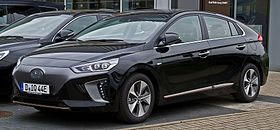 | |
| Overview | |
| Manufacturer | Hyundai |
| Model code | AE |
| Production | 2016–2022[1] |
| Model years | 2017–2022 |
| Assembly | South Korea: Ulsan (all variants) Malaysia: Kulim, Kedah (Hyundai-Sime Darby Motors, hybrid only) Ethiopia: Addis Ababa (Marathon Motors, electric only)[2] |
| Body and chassis | |
| Class | Compact car (C) |
| Body style | 5-door liftback |
| Layout | Front-engine or motor, front-wheel-drive |
| Dimensions | |
| Wheelbase | 2,700 mm (106.3 in)[3] |
| Length | 4,470 mm (176.0 in) |
| Width | 1,820 mm (71.7 in) |
| Height | 1,450 mm (57.1 in) |
| Chronology | |
| Successor | Hyundai Elantra Hybrid (CN7)[4] (South Korea and North America) |
The Hyundai Ioniq (Korean: 현대 아이오닉) is a compact five-door liftback manufactured and marketed by Hyundai.[5][6] The nameplate Ioniq is a portmanteau of ion and unique.[7] It is marketed as the first Hyundai automobile to be offered without a standard internal combustion engine, but rather sold in hybrid, plug-in hybrid, and all-electric variants.[8]
The Ioniq Hybrid debuted in South Korea in January 2016, with all three variants debuting at 2016 Geneva and New York auto shows.[9][6] The hybrid variant launched in its home market in February 2016, followed by the electric model in July 2016.[9][10] The plug-in hybrid version followed in February 2017.[11]
From its first model year (2017) through the 2019 model year, the Ioniq Electric had been the EPA's most efficient vehicle with a rated fuel economy of 136 miles per gallon gasoline equivalent (24.8 kWh/100 mi; 15.4 kWh/100 km).[12][13] The Ioniq Blue Hybrid version has been rated at 4.1 L/100 km (58 mpg‑US), making it the most fuel-efficient hybrid vehicle to be mass-produced.[14]
Following its discontinuation in South Korea in 2021, production of the Ioniq ended in July 2022 in favour of battery electric lineup of Ioniq-badged models starting from the Ioniq 5 hatchback and Ioniq 6 sedan with Ioniq 7 to follow.[1][15]
Ioniq Hybrid
[edit]| Ioniq Hybrid | |
|---|---|
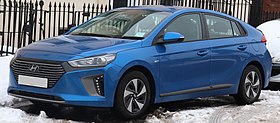 | |
| Powertrain | |
| Engine | 1.6 L Kappa II GDI HEV I4 |
| Electric motor | 32 kW (44 PS; 43 hp)[16] AC Synchronous Permanent Magnet Motor |
| Power output | 77 kW (105 PS; 103 hp) (petrol engine)[16] 139 PS (102 kW; 137 hp) (combined) |
| Transmission | 6-speed DCT |
| Hybrid drivetrain | Parallel |
| Battery | 1.56 kWh lithium-ion polymer battery[16] |
| Dimensions | |
| Curb weight | 1,359–1,469 kg (2,996–3,239 lb) |
The Ioniq is Hyundai's first automobile built from the ground up and specifically available as a hybrid or electric powered. It is related to the Kia Niro crossover utility vehicle and Hyundai Elantra, with which it shares a wheelbase and suspension components.[17]
The Ioniq Hybrid was released in South Korea in February 2016.[9] The hybrid was launched in Malaysia in November 2016. Two Ioniq Hybrid trims were available, HEV and HEV Plus.[18] The Ioniq Hybrid was introduced in the United States for the 2017 model year in early 2017, with journalists granted early access in February of that year.[19] Production of the Ioniq Hybrid halted in July 2022.[20]
Drivetrain
[edit]
The estimated combined total system output is 139 hp (104 kW) with 195 lb⋅ft (264 N⋅m) torque[21] powered by a 1.6-litre Kappa four cylinder Atkinson-cycle engine with 40% thermal efficiency capable of delivering 104 hp (78 kW) with an estimated torque of 109 lb⋅ft (148 N⋅m) plus the electric motor delivers an additional estimated 43 hp (32 kW) with an estimated maximum torque of 125 lb⋅ft (169 N⋅m) for a maximum 147 hp (110 kW) with 234 lb⋅ft (317 N⋅m) torque. Power is delivered to the front wheels through six speed dual-clutch transmission.[16] Neither the Ioniq Hybrid nor Electric is suitable for towing a trailer, like many hybrids and electrics.[22]
The traction battery for the Ioniq Hybrid is a 240 V, 1.56 kWh lithium-ion polymer battery which is positioned beneath the rear passenger seats.[16] Accessories and instrumentation are powered by a smaller 12 V battery, also housed under the rear seats. The 12 V accessory battery also uses lithium-ion chemistry, unlike typical hybrid and internal combustion automobiles which typically use a lead-acid accessory battery.[17]
Chassis
[edit]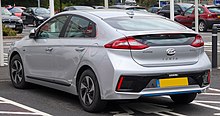
Its aerodynamic design helped lower the drag coefficient of the Ioniq down to 0.24.[21] Excessive weight is reduced by utilization of high strength steel for the structure and aluminium for non structural components.[9] The Ioniq uses aluminium in the hood and tailgate, reducing weight by 27 lb (12 kg) compared with conventional steel, with no measurable disadvantages in noise or vibration.[16] With a higher usage of lightweight components and a more compact build, the cargo screen cover is about 25% lighter than the types used in other Hyundai models.
The hybrid version competes with, and surpasses in fuel economy, the previous mileage leader in the Toyota Prius.[14] Hyundai expects the model with 15-inch wheels to obtain an EPA rated combined fuel economy between 57 mpg‑US (4.1 L/100 km; 68 mpg‑imp) and 58 mpg‑US (4.1 L/100 km; 70 mpg‑imp), just ahead of the 2016 Toyota Prius at 56 mpg‑US (4.2 L/100 km; 67 mpg‑imp).[23] The Ioniq is also available with a 17-inch alloy rim option. Trims that include the alloy rims produce approximately 5 MPG lower overall fuel economy on the highway.
Many parked Ioniq vehicles appear in the early scenes of the 2018 film Johnny English Strikes Again, starring Rowan Atkinson.
Ioniq Electric
[edit]| Ioniq Electric | |
|---|---|
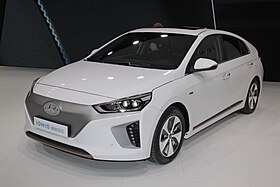 | |
| Powertrain | |
| Electric motor | Front-engine rear-battery Permanent Magnet Synchronous Motor |
| Power output | 89 kW (120 hp); 295 N⋅m (218 lb⋅ft) (2016–2019) 100 kW (134 hp); 295 N⋅m (218 lb⋅ft) (2019–2022) |
| Transmission | 1-speed automatic |
| Battery | 28 kWh lithium-ion polymer battery[5] (2016–2019) 38.3 kWh lithium-ion polymer battery (2019–2022) |
| Electric range | 2016–2019: 124 mi (200 km) (EPA)[24] 280 km (174 mi) (NEDC)[5] 169 km (105 mi) (South Korea)[5] 2019–2022: 170 mi (274 km) (EPA) 310 km (193 mi) (WLTP) 200 km (124 mi) (South Korea) |
| Plug-in charging | 6.6 kW (2016–2019) 7.2 kW (2019–2022) |
| Dimensions | |
| Curb weight | 1,420–1,575 kg (3,131–3,472 lb) |
The Hyundai Ioniq Electric is a limited-production all-electric version of the Ioniq that is sold only in select countries and US states. It features a 28 kWh lithium-ion polymer battery that delivers an EPA-rated range of 124 mi (200 km).[5][24] The car was refreshed for the 2020 model year with a new interior, larger battery, and increased range and traction motor output.[25]
Initially, the Ioniq Electric was available in the United States in California only.[26] As of 2019, Hyundai USA sells the Ioniq Electric only in select states.[which?][27] It is sold by Hyundai in other countries as well, which as of December 2018[update] included Canada,[28] Norway,[29] Netherlands, Portugal[citation needed] and Switzerland.[30] The car was discontinued in the US market for the 2022 model year.[31]
Drivetrain and chassis
[edit]The Ioniq Electric is bundled with the portable "In-Cable Control Box" (ICCB), an electric vehicle supply equipment that allows drivers to charge their Ioniq using a conventional household outlet, but this is recommended only for use in emergencies in countries with 120 V AC outlets.[32] In most countries with 220–240 V AC household outlets, 100% range can be added with an overnight charge.[33] The charging plug of the car is located in a position where fuel fillers are normally located;[5] the vehicle is equipped with a CCS Combo 1 inlet, accepting charging rates at up to 100 kW at a DC fast charging station, although the 38kwh version would only accept a 50kw ‘fast’ charge.[26]
The electric traction motor has a rated output of 118 hp (88 kW) and 215 lb⋅ft (292 N⋅m).[26] Power output was increased to 134 hp (100 kW) with the 2020 refresh; peak torque increased modestly to 218 lb⋅ft (296 N⋅m).[25]
The Ioniq features paddle shifters to allow drivers to choose from one of four levels of regenerative braking.[34] Single-pedal control is not possible: the driver must use the brake pedal to come to a complete stop, even at maximum regeneration. There are three driving modes (Eco / Normal / Sport) which affect throttle tuning; in addition, Eco decreases the output of the climate control system.[35] For the 2020 model year, holding the regeneration paddle enabled maximum regeneration and one-pedal driving.[25]
The rear suspension was switched to a torsion beam instead of the multilink setup used on the Ioniq Hybrid to accommodate the larger traction battery, which is carried under the rear seat.[26]
Range and efficiency
[edit]
Under the U.S. Environmental Protection Agency (EPA) four cycle test, the 2017 Ioniq Electric combined fuel economy rating is 136 mpg‑e (24.8 kWh/100 mi; 15.4 kWh/100 km). For city driving, it is rated at 150 mpg‑e (22 kWh/100 mi; 14 kWh/100 km), and for highway it is rated at 122 mpg‑e (28 kWh/100 mi; 17.2 kWh/100 km).[24]
With these ratings, the Ioniq Electric became in November 2016 the most efficient EPA certified vehicle considering all fuels and of all years, surpassing the 2014–2016 model year BMW i3, and also the 2017 Toyota Prius Prime, the most energy efficient plug in hybrid in EV mode.[12][13] Similarly the Ioniq Electric was praised by the Green NCAP for high energy efficiency, even under high-load highway test.
| Test | Points | ||||||||||||||||||||||||||||||||||||||||||||||||||||||||
|---|---|---|---|---|---|---|---|---|---|---|---|---|---|---|---|---|---|---|---|---|---|---|---|---|---|---|---|---|---|---|---|---|---|---|---|---|---|---|---|---|---|---|---|---|---|---|---|---|---|---|---|---|---|---|---|---|---|
| Overall: | |||||||||||||||||||||||||||||||||||||||||||||||||||||||||
| |||||||||||||||||||||||||||||||||||||||||||||||||||||||||
| |||||||||||||||||||||||||||||||||||||||||||||||||||||||||
Range from the relatively modest battery was increased by the vehicle's efficiency, which in turn was aided by aerodynamic tweaks and low-rolling resistance tires.[26] The 2017 Ioniq Electric had a combined EPA rated range of 124 mi (200 km).[24] Hyundai originally expected the Ioniq to deliver a range of 110 mi (180 km).[34] The range under the New European Driving Cycle (NEDC) standard is 280 km (170 mi),[37] and 169 km (105 mi) under the South Korean cycle.[5] In 2019 (2020 model year), the battery capacity was increased to 38.3 kW-hr, lengthening the range to 170 mi (270 km) (EPA) or 311 km (193 mi) (WLTP).[38]
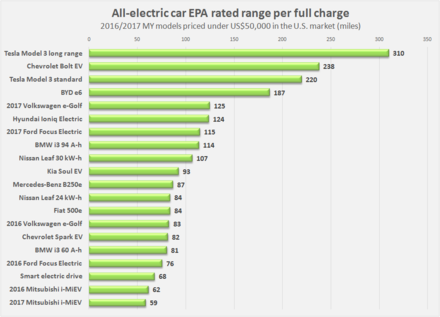
Charging time is rated at 4 hours on a 6.6 kW AC charger.[41] Using a DC fast charging station, the battery can be restored to 80% state of charge in approximately half an hour.[35] Along with the larger battery, the onboard AC charger was upgraded from 6.6 kW to 7.2 kW with the 2020 model year Ioniq Electric.[25]
Ioniq Plug-in
[edit]| Ioniq Plug-in | |
|---|---|
 | |
| Powertrain | |
| Engine | 1.6 L Kappa II GDI PHEV I4 |
| Electric motor | 44.5 kW (59.7 hp)[5] Permanent Magnet Synchronous Motor |
| Power output | 78 kW (105 hp) (petrol engine)[16] |
| Transmission | 6-speed DCT |
| Hybrid drivetrain | Plug-in hybrid |
| Battery | 8.9 kWh lithium-ion polymer battery[5] |
| Electric range | 29 mi (47 km) (EPA)[5] |
| Dimensions | |
| Curb weight | 1,495–1,551 kg (3,296–3,419 lb) |
The plug-in hybrid variant was released in February 2017.[42]
The Ioniq Plug-in uses a similar hybrid electric drivetrain as the regular Ioniq Hybrid,[43] which combines the same 1.6-L GDI four-cylinder Kappa engine as the Hybrid, rated at 40% thermal efficiency and an output of 78 kW (105 hp) and 150 N⋅m (111 lbf⋅ft), with a slightly more powerful electric motor that develops 45 kW (60 hp) and 170 N⋅m (125 lbf⋅ft).[5][16][44] Compared to the regular Hybrid, the Plug-in also has a larger 8.9 kWh lithium-ion polymer traction battery capable of delivering an EPA-rated electric-only range of 29 mi (47 km), and an additional 601 mi (967 km) of range in hybrid mode once the electric range has been depleted.[45] The EPA efficiency rating for the Ioniq Plug-in hybrid in electric mode is 119 mpg‑e (28 kWh/100 mi; 17.6 kWh/100 km).[45]
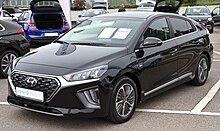
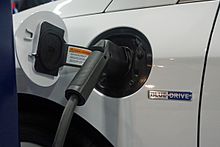
In ECO mode, the dual clutch transmission optimizes gear selection for efficiency, upshifting earlier to achieve better fuel economy.[16] There is a charge-replenishing mode where the gasoline engine is used to recharge the traction battery - for example, when the combustion engine is being used for heating during cold season.

Sales
[edit]By January 2021, from the Ioniq series around 325,500 units were sold worldwide, including 211,755 conventional hybrids and 77,972 purely electric cars, as well as 35,757 plug-in hybrid variants. From all units, 118,575 were sold to Europe and 60,354 to the USA. From the IONIQ electric model 36,772 units were sold to Europe; these are 47% or almost the half of the worldwide electric production.[46]
See also
[edit]- Government incentives for plug-in electric vehicles
- Hyundai Sonata PHEV
- List of electric cars currently available
- List of modern production plug-in electric vehicles
- Plug-in electric vehicle
- Hyundai Ioniq 5
- Hyundai Ioniq 6
- Ioniq
References
[edit]- ^ a b Lemkes, Jan (3 June 2022). "HYUNDAI IONIQ UIT PRODUCTIE" (in Dutch). AutoWeek. Archived from the original on 3 June 2022. Retrieved 10 August 2022.
- ^ Kuhudzai, Remeredzai Joseph (27 July 2020). "1st Ethiopian-Assembled All-Electric Hyundai Ioniq Rolls Out Of Haile Gebrselassie's Marathon Motor Engineering Plant". Archived from the original on 17 April 2022.
- ^ "2019 Hyundai IONIQ (facelift 2019) 1.6 GDI (141 Hp) Plug-in Hybrid DCT". Auto Data. n.d. Archived from the original on 14 October 2019.
- ^ "아이오닉(IONIQ) 하이브리드 단종의 이유는?" (in Korean). Donga. 7 April 2020. Archived from the original on 28 April 2021.
- ^ a b c d e f g h i j k Kane, Mark (2 March 2016). "Hyundai IONIQ Electric & IONIQ Plug-in At The Geneva Motor Show (Gallery, New Stats)". InsideEVs. Archived from the original on 5 May 2021. Retrieved 2 March 2016.
- ^ a b Park Jin-hai (14 January 2016). "Hyundai launches Ioniq hybrid compact". Korea Times. Archived from the original on 6 March 2016. Retrieved 2 March 2016.
- ^ Cobb, Jeff (1 February 2016). "Who Else Besides Toyota Will The Hyundai Ioniq Threaten?". HybridCars.com. Archived from the original on 3 February 2016. Retrieved 20 February 2016.
- ^ Howard, Bill (21 February 2017). "2017 Hyundai Ioniq first drive review: hybrid, EV, plug-in, no gas-only engines". Extreme Tech. Archived from the original on 15 June 2022.
- ^ a b c d Joseph, Noah (14 January 2016). "Hyundai Ioniq launches in Korea before challenging Prius in US [w/video]". Autoblog.com. Retrieved 20 February 2016.
- ^ "Hyundai's Ioniq EV sales top 1,000 units". Yonhap News Agency. 12 September 2016. Archived from the original on 22 January 2017. Retrieved 22 September 2016.
- ^ Szostech, Michael. "Hyundai IONIQ Availability". My Electric Car Forums. Archived from the original on 2 February 2017. Retrieved 28 January 2017.
- ^ a b "Fueleconomy.gov Top Ten". US Department of Energy. 2015. Archived from the original on 9 February 2015. Retrieved 23 November 2019.
The 2014–15 BMW i3 BEV was the most efficient EPA certified vehicles considering all fuels and of all years until November 2016, when it was surpassed by the Hyundai Ioniq Electric
- ^ a b Edelstein, Stephen (21 November 2016). "Hyundai Ioniq Electric beats Prius Prime, BMW i3 on energy efficiency". Green Car Reports. Retrieved 21 November 2016.
- ^ a b "Compare Side-by-Side". US Department of Energy. n.d. Archived from the original on 9 January 2019. Retrieved 9 January 2019.
- ^ "Farewell to a true trailblazer: Hyundai announces end of production for first IONIQ series". www.hyundai.news. 6 March 2022. Archived from the original on 15 June 2022. Retrieved 12 June 2022.
- ^ a b c d e f g h i Mike Millikin (24 March 2016). "Hyundai unveils Ioniq HEV, PHEV and EV for US market at New York show". Green Car Congress. Archived from the original on 21 September 2021. Retrieved 24 March 2016.
- ^ a b Robinson, Aaron (28 April 2017). "Pennywiser: 2017 Hyundai Ioniq Hybrid Tested!". Car and Driver. Archived from the original on 29 July 2022. Retrieved 29 July 2022.
- ^ "Hyundai Ioniq Hybrid in Malaysia: CKD, 7 airbags, from RM100k; RM111k with AEB and Smart Cruise Control". Paul Tan's Automotive News. 29 November 2016. Archived from the original on 8 March 2022. Retrieved 1 December 2016.
- ^ Voelcker, John (21 February 2017). "2017 Hyundai Ioniq Hybrid: first drive review". Green Car Reports. Archived from the original on 29 July 2022. Retrieved 29 July 2022.
- ^ Edelstein, Stephen (7 June 2022). "High-mpg Hyundai Ioniq plug-in and hybrid versions are going away, as Ioniq goes all-EV". Green Car Reports. Archived from the original on 19 June 2022. Retrieved 29 July 2022.
- ^ a b Cobb, Jeff (14 January 2016). "Hyundai Ioniq Hybrid Gets Better Fuel Economy Than A 2015 Toyota Prius – In Korea". HybridCars.com. Archived from the original on 24 January 2016. Retrieved 20 February 2016.
- ^ Custard, Ben (9 May 2022). "Review: Hyundai Ioniq Hybrid". Car Buyer UK. Retrieved 7 January 2017.
- ^ Cobb, Jeff (23 March 2016). "Hyundai Ioniq Hybrid Projected To Achieve 57 or 58 mpg". HybridCars.com. Archived from the original on 3 April 2016. Retrieved 24 March 2016.
- ^ a b c d United States Environmental Protection Agency and U.S. Department of Energy (16 November 2016). "Compare Side-by-Side: 2017 Hyundai Ioniq Electric". fueleconomy.gov. Retrieved 19 November 2016.
- ^ a b c d Stafford, Eric (15 July 2020). "Tested: 2020 Ioniq Electric Runs Farther on Its New and Larger Battery". Car and Driver. Retrieved 27 July 2022.
- ^ a b c d e Fink, Greg (15 August 2017). "Tested: 2017 Hyundai Ioniq Electric". Car and Driver. Retrieved 27 July 2022.
- ^ "2019 Ioniq Electric". Hyundai USA. Retrieved 12 October 2019.
- ^ "Ioniq Electric". Hyundai Canada. Archived from the original on 8 November 2018. Retrieved 4 June 2019.
- ^ "Ioniq Electric" (in Norwegian). Hyundai Norway. Archived from the original on 24 December 2018. Retrieved 23 December 2018.
- ^ "Ioniq Electric" (in German). Hyundai Switzerland. Archived from the original on 26 October 2016. Retrieved 23 December 2018.
- ^ "2022 IONIQ Hybrid - Carry-over". Hyundai. 2022. Retrieved 10 August 2022.
- ^ Taylor, Alun (4 January 2017). "Hyundai Ioniq and Kia Niro review: Korean tanks parked on Japan's lawn". Ars Technica.
- ^ "Hyundai IONIQ Electric Charger – Pod Point".
- ^ a b Voelcker, John (21 March 2016). "2017 Hyundai Ioniq Electric to offer 110 miles of range: company". Green Car Reports. Retrieved 21 March 2016.
- ^ a b Cunningham, Wayne (18 July 2017). "2017 Hyundai Ioniq Electric review: Hyundai's Ioniq Electric drives nice, but new competition beats it on range". Road/Show. CNet. Retrieved 27 July 2022.
- ^ "Green NCAP assessment of the Hyundai Ioniq". greenncap.com. 2019.
- ^ "Hyundai Prices IONIQ Electric". 22 June 2016. Retrieved 22 January 2017.
- ^ Kane, Mark (6 June 2022). "Hyundai Ioniq Electric And Ioniq Plug-In Production Comes To An End". Inside EVs. Retrieved 27 July 2022.
- ^ Energy Efficiency & Renewable Energy, U.S. Department of Energy and U.S. Environmental Protection Agency (14 September 2016). "Find a car – Years: 2016–2017 – Vehicle Type: Electric". fueleconomy.gov. Retrieved 26 March 2017.
- ^ Krok, Andrew (29 July 2017). "By the numbers: Tesla Model 3 vs. Chevrolet Bolt EV". CNET. Retrieved 29 July 2017.
- ^ Fuel Economy Guide, Model Year 2017 (PDF) (Report). United States Environmental Protection Agency. 2016. pp. 32–36. Retrieved 6 January 2025.
- ^ "Hyundai's Ioniq surpasses 30,000 in global sales". Yonhap News Agency. 5 March 2017. Archived from the original on 9 March 2017. Retrieved 26 March 2017.
- ^ Halvorson, Bengt (14 March 2017). "First Drive: 2018 Hyundai Ioniq Plug-In Hybrid". Car and Driver. Retrieved 2 August 2022.
- ^ Stewart, Ben (12 December 2017). "2018 Hyundai Ioniq Plug-In Hybrid first drive: Going after gasoline". Autoweek. Retrieved 2 August 2022.
- ^ a b "2019 Hyundai Ioniq Plug-in Hybrid Fuel Economy". U.S. Environmental Protection Agency. Retrieved 13 April 2021.
- ^ "Sales Performance". Hyundai. 2015. Archived from the original on 23 March 2021.
External links
[edit]- Official website (electric)
- Official website (hybrid)
- Official website (plug-in hybrid)
